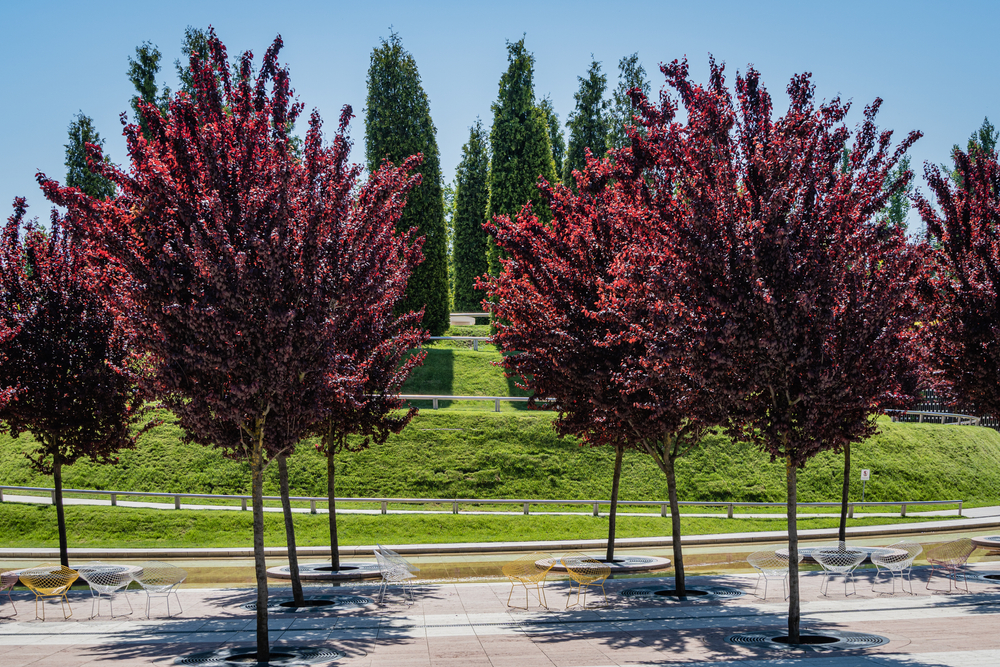If you’re interested in planting a Purple Leaf Plum Tree but aren’t sure if it’s the right fit for you or your garden, here’s a breakdown of all the pros and cons list of them to help you with your decision.
Purple Leaf Plum Tree Pros
- Economically priced compared to other ornamentals
- Hardy biology with a broad range of environmental tolerances
- A wide variety of cultivars are available to choose from
- Has beautiful purple and red leaves
- Requires minimum pruning maintenance
Purple Leaf Plum Tree Cons
- Most cultivate do not perform well in urban environments
- Most cultivars produce fruit that can attract unwanted wildlife
- Prefers moderately rich soils
- Purple leaf plum tree plums are edible but not palatable
Purple Leaf Plum Tree Biology
The purple leaf plum tree (Prunus cerasifera) is a small to medium-sized deciduous tree that grows in USDA hardiness zones 4-8. Zone 4a is the coldest environment Prunus cerasifera can tolerate, with an average winter low of -30 degrees Fahrenheit.
Prunus cerasifera’s hardy tolerances and showy aesthetic make it ideal for medium-sized gardens and ornamental landscapes. The species’ bright, highly pigmented flowers that bloom at the first hint of spring make it popular among landscape designers.
In addition to its aesthetic appeal, Prunus cerasifera grows an edible drupe that is an important food source for birds and small mammals. A drupe is a fruit with a hard central stone, like a plum.
Who Should Consider Planting a Purple Leaf Plum Tree?
Prunus cerasifera is a versatile tree that will perform well in most ornamental environments within its hardiness zone. If you are unsure as to what hardiness zone you live in, check the USDA’s Hardiness Zone Map. If you live in zones 4 through 8, then Prunus cerasifera will grow in your climate.
However, appropriate temperature ranges are only part of what makes or breaks a Prunus cerasifera planting. Soil quality, water availability, and landscape use patterns are all qualities of an environment that will influence how well a Prunus cerasifera will establish and grow.
Soil Quality
Prunus cerasifera requires neutral to slightly acidic loamy soils. Well-maintained gardens or lush natural landscapes may have soil that will nourish a Prunus cerasifera without amendment. However, it is more likely that the site you plan to plant your new tree will need to be amended with fertilizer and organic matter.
Water Availability
Prunus cerasifera requires a moderately high amount of water. Environments that fall within the higher temperature tolerance of the Prunus cerasifera should consider augmenting their tree’s natural water supply with regular hose waterings.
The amount of water a Prunus cerasifera receives is as important as the frequency of the watering. Prunus cerasifera does not tolerate anaerobic conditions and will decline rapidly in inundated soil.
Ensuring proper drainage of the soil that supports your Prunus cerasifera will increase the life of your tree. Water only when necessary and increase the frequency of watering over the volume of watering.
Land Use Patterns
How the area around your Prunus cerasifera is used will also affect how the tree establishes itself.
Prunus cerasifera usually does poorly in urban environments. Limited natural space, poor soil quality, pollution, and flooding are just some of the common threats Prunus cerasifera faces in urban environments.
Homeowners in metropolitan cities with small backyards or high pollution statistics (cities like New York City or Los Angeles) may achieve greater planting success with other tree species or shrubs.
Homeowners in suburban or rural areas will run into fewer issues with their Prunus cerasifera planting, but land use patterns should still be considered. Prunus cerasifera does not tolerate heavily shaded areas or soil compaction.
Even if your neighborhood experiences limited foot traffic, frequent play, or recreational use of the area near your Prunus cerasifera, it may compact the soil and negatively affect the growth and longevity of your tree.

